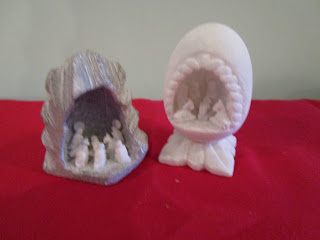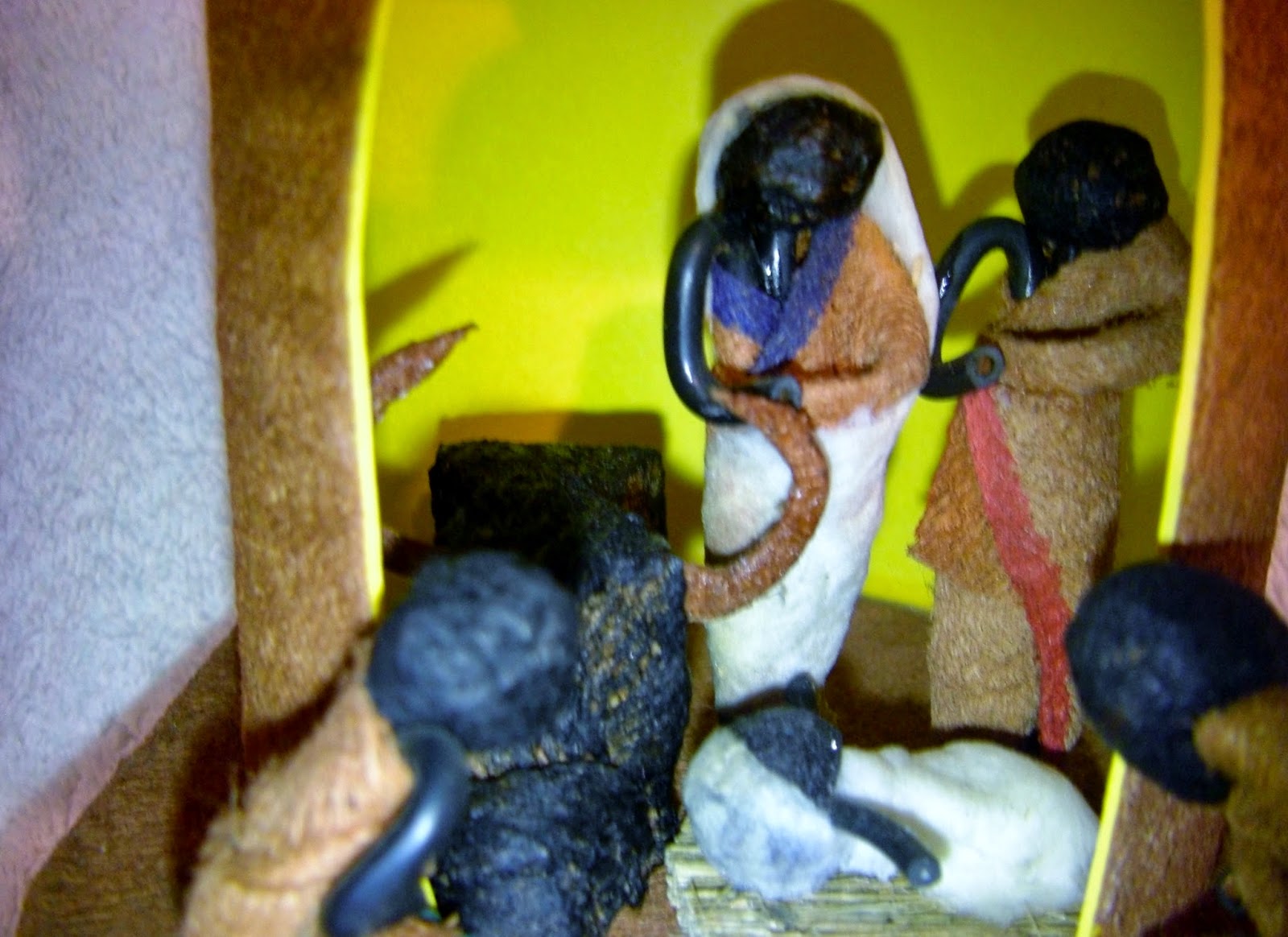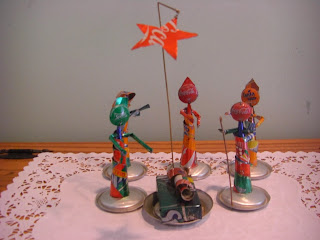 |
| A puzzle made in Morocco that we got at The Tabernacle gift shop in Lancaster, PA. It was one of many puzzles, most of which were of Amish scenes. |
One of the deep-rooted custom in culture and Peruvian folklore, are the “nacimientos”: nativity scenes.
The assembly of the nativity is a tradition that, at the beginning of the colonial stage, used to be an instrument for evangelization brought from Spain by the Congregation of the Jesuits. Throughout the years, each region in Peru started to develop it’s own ”nacimientos” based on typical elements of each region. A nativity in Cusco, for example, is very different from the typical ones from Lima or Ayacucho, where the nativities are called ‘retablos’. Each province has it’s own way to show their Christmas fervor. In the northern provinces of Peru the nativities are made our of mud; other provinces mix Inca and Spanish culture and incorporate elements from different periods. Also the “Ashaninkas” – the indigenous people of the jungle – have their own Christmas nativity scenes and rituals: the cribs are visited by little shepherds who sing Christmas carols to the Child. (https://www.amautaspanish.com/blog/peruvian-nativities-cusco-typical-christmas/)
The next nine pictures are all of nativities from Peru
 |
| The one on the left was purchased in North Beach, MD and the one on the left was a gift from a friend. |
 |
| Alabaster. The one on the left was given to me by the daughter of a resident of Sacred Heart Home where I began collecting nativities (see the post "How it all got started") |
 |
| Retablos |
 |
Clay |
 |
| Clay. I love how they are dressed, very typical of Peruvian nativities |
 |
| Clay |
 |
| We were given this nativity from Guatemala soon after we began collecting nativities. |
 |
| A former co-worker gave me this bookmark that she had purchased in Egypt. |
 |
| Our daughter, Kathy, led a mission trip to Guatemala in 2018 She brought this back and gave it to me for my birthday. . |
 |
| Davidsonville UMC had a fundraiser for 10,000 Villages. We bought this nativity that was made in Viet Nam |
Front view of carved Massai nativity that we found in a flea market in Norfolk.
Back view of Massai nativity
Nativity we found in a store in Cabo San Lucas when we were on our cruise in 2013 that went from Ft Lauderdale to San Diego through the Panama Canal.
Carved wooden nativity that we found at the Irish Bible Society store in Dublin, Ireland. There is no indication of the country of origin on the figures or on the box But one figure, on the underside, mentions an Irish distributor. On our entire two week cruise around the British Isles this was the only nativity that we found.
Carole was always intrigued by the nativity made out of Coke cans that she saw one year at the annual Nativity Display at the Washington Cathedral in Washington, DC. Kathy found this soda can from Kenya on the internet and gave it to Carole for Christmas 2012.
 |
| This case is almost all Latin American nativities |
The next eight pictures are of nativities we purchased while in Costa Rica, August 16-November 12, 2013. We were able to do a lot of sightseeing while serving as Mission Nannys.
Joseph got lost on two of the three nativities. Probably happened in transit.
This is a candle we found in Walmart. According to the label it was made in Costa Rica for Walmart.
We found this in the Escazu farmers market. It is handmade.
Found in Walmart in Escazu
While we were living in Costa Rica we stayed at Lilliana's house. She and her boyfriend gave us the following signed and numbered print by Alfieri, a New York born artist. It is titled "Pasito" which is Spanish for nativity. It is dated 2007.
Philip Alfieri “Pacito” lithograph signed in pencil and
numbered print 30/175
Philipi Alfieri studied at the university of Miami, Florida,
the Art Students League, New York, and at the Under Bosa, Corbino, Bouche. He
has received awards from the following: Prix D'Rome Finalist, Six Greenwich
Village Exibition, New York University Scholarship, and West Side Savings
Traveling. He has had numersous exibitions throughout the United States,
including Collectors Gallery, Manhasset, New York; Fountainbleau Gallery,
Miami, Florida; Stamford Museum, Stamford, Connecticut; Verzyl Gallery,
Northport, New York; Beckman Gallery, Maine; and Golden Door, New Hope,
Pennsylvania. His work is represented in the art collections
ALFIERI--Philip S., 88 years old, of Rego Park,
NY died on Friday April 10 at Park Manor in Bloomfield. Philip was born in
Rochester, NY and lived in Newark and in Queens for the last 55 years. He was a
professional painter and portrait artist.
The following olive wood ornaments all came from the Holy Land. Although not always marked, most olive wood ornaments are made in Jordan
 |
| Brought back from Austria by Ginger and Mark when they took their 25th anniversary cruise down the Danube. |
 |
| Gift from Ginger and Mark. |
 |
| Close up of interior of nativity above |
 |
| From Germany. In a walnut shell. A gift from Doris Schmidt |
 |
| Made in the Philippines of abaca fibers. We found this at the Christmas ship at the Biltmore Estate in Ashville, NC |
Carole took the fronts of inlaid banana bark cards and put them on a ribbon. "These were made in Haiti and distributed by Food for the Poor. Inc. Food for the Poor was founded in 1982 to link the church of the first world with the church of the third world in a manner that helps both the materially poor and the poor in the spirit. The organization is unique in that it tailors its aid efforts to fit the specific needs of each program it enter, custom-fitting operations with what is actually needed in the field.. The Banana Bark program helps give mothers dignity, enabling them to provide for their children through honest work."
The following pictures are of the jackaranda tree at Betty Sullins home in Santa Barbara, CA.
 |
| A jackaranda tree in bloom in front of Betty Sullins mobile home in Santa Barbara, CA |
German Pyramid of Light (see explanation under Nativities made from wood)
 |
| Add caption |
 |
| When Mark and Ginger went to Antartica they sailed from the southernmost city in the world: Ushuaia, Argentina where they bought this nativity. |
 |
| From the Philippines |
 | ||
Emmy bought this nativity from Murano, Italy when she took an art class in Italy, summer of 2015. In 1291, the
mayor of Venice, Italy ordered that all glass factories move to the island of
Murano to prevent harmful factory fires from affecting Venice. Since then, Murano glass has developed a reputation for
beauty and color. Murano glass is first identified by its location, then its
factories, and finally its designers. You can identify these sources with a
certificate of authenticity, a master glass maker signature or a Murano glass
catalog.
|









.JPG)
.JPG)
















No comments:
Post a Comment